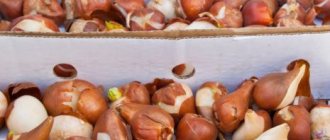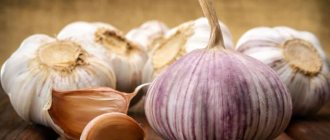Garlic is a valuable product, because it is not for nothing that many people prefer to treat various diseases with it rather than with medications. Firstly, it is healthy, and secondly, garlic is more effective than many tablets and syrups. Also, like greens, it adds a special taste and piquancy to dishes, for which it is appreciated even more.
Garlic is rich in vitamins C, B1, B2, B6, PP, as well as potassium, calcium, manganese, selenium, iodine, phosphorus, magnesium, sodium, iron and zinc. It also contains proteins, fats and carbohydrates, although you may gain weight from eating garlic not because of its composition, but because of its ability to whet the appetite. A small minus is the specific aroma and aftertaste, but the benefits of a small, vigorous vegetable outweigh these minor minuses. Regular consumption of garlic helps strengthen the immune system, cleanse the body of parasites, normalize blood pressure, help the thyroid gland produce hormones, improve the functioning of the cardiovascular and respiratory systems, and have a positive effect on the reproductive system.
Despite the fact that this healthy vegetable is sold in stores all year round, you want to buy more to stock up on it for future use. But you need to organize proper garlic at home. This is especially important for those who themselves planted garlic in the beds, cared for and grew it. In this article, we will tell you how to properly store garlic at home so that it does not sprout or dry out by winter.
Preparation for storage
Garlic can be winter or spring. What is the difference between spring garlic and winter garlic, and how to store garlic for the winter? Winter garlic is planted before winter. In early spring it gives the first shoots, and at the end of July you can harvest. Spring garlic is planted in early spring and dug up in August.
The shelf life of the garlic depends on the type of garlic. Winter crops can be stored until January-February, and spring (summer) crops can be stored until spring. Therefore, both types can be stored for the winter.
Before storing the product, it must be prepared. The same rule applies to garlic. Storing garlic in winter is not difficult, because it can be stored even in a city apartment.
In order for garlic to be stored longer and not spoil, it also needs to be prepared for storage in advance. Proper storage of vegetables will ensure the safety of all valuable substances in it and increase its shelf life. Timely harvesting and storage of garlic is an interconnected process. Preparing garlic for storage consists of several stages, see which ones below.
When preparing, you should pay special attention to these points:
- harvesting. It is recommended to adhere to harvest dates. If you dig up the garlic at the right time, the garlic heads will not disintegrate into cloves and, therefore, will be better stored. This type of garlic is called spring or winter. Garlic is harvested in late July - early August;
- digging When digging up garlic, it is important not to damage the vegetable with a shovel or other sharp objects. You cannot pull garlic by the arrows like carrots by the tops while it is still in the ground, knock on each other, on the ground or on a shovel to clear the soil after digging. To avoid cracks and damage, as well as to better preserve the crop, it must be carefully cleaned by hand after digging;
- drying. After the crop is harvested (after digging and cleaning), it should be left in a dry room for several days to dry. This usually takes 5-7 days. Vegetables should be dried by hanging the tops from the ceiling. Thus, the nutrients contained in the stems will go to the heads, and the vegetables will retain their taste and usefulness;
- sorting. After digging and drying the harvest, the garlic should be sorted. Separately, you need to set aside garlic with damage (scratches, dents) and defects (growths, stains). Garlic is also sorted by the size of the heads.
If part of the garlic was damaged during harvesting, then such fruits are not suitable for storage. They need to be eaten or processed (for example, minced with tomatoes).
Harvesting
Before talking about garlic storage technologies, it is worth recalling the harvesting rules. After all, if you make mistakes at this stage, then most likely it will not be possible to correct them.
As a rule, winter garlic, planted in the fall under snow, ripens by the end of July. The ripening time for garlic planted in spring (spring) ranges from late August to mid-September - depending on the number of sunny days and average daily temperature.
It is advisable to choose a sunny, dry day to dig up garlic. It will be better if there is no serious precipitation a week or at least four to five days before - you should also refrain from watering. Then by the chosen day the earth will be sufficiently dry. When digging, you should use a fork rather than a shovel - this reduces the risk of damaging the heads.
The dug up garlic just needs to be shaken off the ground and then laid out directly on the garden bed to dry - there is no need to cut off the stems. It must be stored in this state for five days. If rain is expected, then it makes sense to protect the crop from bad weather, for example, by placing it in a greenhouse, gazebo, terrace or simply under a canopy. But in any case, it should be a warm, well-ventilated room.
When the garlic dries thoroughly and its top layer becomes hard and does not allow moisture to pass through, you can trim the roots - just leave no more than three millimeters. Then the stem is cut off - it is advisable to leave at least ten centimeters. For pruning, you can use both regular scissors and garden pruners.
Storage period and conditions
To store garlic until spring, it is important to follow three basic rules:
- Optimal storage temperature for garlic. Spring garlic is best stored at a temperature not exceeding 20 degrees, and winter garlic - at a temperature not exceeding 10 degrees.
- Humidity. It is necessary to store garlic in a room where the humidity does not exceed 70%, otherwise there is a risk of the heads rotting (this applies to both spring and winter garlic).
- Light and warmth. Garlic should not be stored in a brightly lit place, especially in areas with direct sunlight. You also need to make sure that the product is far away from any heating devices. This is how you need to store garlic in winter so that it does not dry out. Intense light and heat cause the heads to separate into segments, which soon become less tasty and healthy. Dry garlic loses not only weight, but also valuable substances.
If you strictly follow these storage rules, then the garlic will not spoil for a long time and will remain as healthy as freshly harvested.
The shelf life of garlic depends on the place and method of its storage. For example, it can be stored in craft bags in the refrigerator for about 3 months, in the freezer - 4 months, in vegetable oil - 3-4 months, ground - 2 months. It can be stored in a pantry or kitchen cabinet throughout the winter, in a basement or cellar for 4 months, in an attic or balcony for up to six months.
General recommendations
In order for garlic to be stored for a long time, it is important to fulfill the following conditions:
- choose a variety belonging to the category of long-term varieties;
- Before planting, treat the teeth with preparations that protect against pests and diseases;
- during the growing process, strictly observe all agrotechnical standards (watering, fertilizing, removing weak and diseased plants, etc.);
- Before storing, thoroughly dry and sort the heads;
- comply with all storage rules .
Garlic can be preserved well at home, but it is important to ensure optimal conditions for this. At what temperature should crops be stored? At +15…20 ℃ when choosing a warm storage method and at +2…4 ℃ when storing in the cold.
Creating favorable storage conditions will help preserve the juiciness, aroma and beneficial properties of the product.
It is also important to monitor air humidity. In the storage area, it should not be too low so that the garlic does not dry out, or high, otherwise the crop will quickly rot. To prevent garlic from germinating, the humidity level should be within 50%.
There is absolutely no point in storing garlic heads in the refrigerator (the humidity there is always much higher than necessary).
Before storing garlic, trim the roots and stems. This will reduce the risk of rotting and sprouting, which will allow you to save vegetables until spring
Storage methods
People have used many methods when storing at home. The main thing is protection from heat, light and humidity. You can store garlic for a long time in a cellar, basement, pantry, or glassed-in balcony. It is stored in dry, dark places, for example, in a sofa, closet, nightstand. Some people prefer to store garlic in braids (tie several heads by the arrows into one braid and hang them in the cellar) or in glass jars in bulk substances (salt, flour, ash, sawdust) that can absorb excess liquid, in cardboard boxes and wooden boxes.
Garlic should not be stored in a plastic bag or wrapped in cling film. Without air access it will become damp and moldy.
To prevent garlic from germinating, its roots must be cut and burned with a blowtorch or gas torch before storage.
Let's consider information on how to store garlic at home, and which methods are more reliable.
In banks
One of the simplest methods for storing garlic is storing it in jars. Everyone has them, and you don’t have to look for a special place to store your harvest, because the jars can be placed in a regular cupboard. Glass containers will not allow bacteria and fungi to spoil the product. Organizing such vegetable storage is not difficult. You need to place the heads of garlic in a clean and dry container to the top and close with a lid. Instead of a lid, you can use a piece of gauze or cotton cloth.
You can store garlic divided into cloves without removing the scales. This method will allow more cloves to fit into the jar. But there is one advantage to this: when dividing the garlic into cloves, you can check if there are any damaged parts in the head that could spoil the remaining whole pieces.
The jar can be filled with auxiliary substances, for example, flour, salt, rice, sawdust. The main condition is clean and dry containers. Some people prefer to store garlic in a vacuum, in oil or even in wine. Storing garlic in an apartment is a common thing, but there are a few tricks. We invite you to find out.
In flour
If you use flour as a filler for storing garlic, it will prevent it from compacting and becoming damp. To do this, you need to pour dry flour into the bottom of a glass jar (2 or 3 liters) in a layer of about 2-3 cm. Then you need to put several heads there, roots down, as when planting, and sprinkle with flour again. This should be repeated until the jar is full.
The heads must not touch each other.
The jar is closed with a nylon lid to avoid the appearance of pests. You can store garlic in flour even in disassembled form, but there is no need to peel the cloves from the protective film, then it will better retain its beneficial properties.
In salt
Like flour, salt is an excellent insulating agent for storing garlic. In addition, it also disinfects. Therefore, the likelihood that mold will appear in garlic when stored in salt is very low.
To store garlic for the winter, you need to take any salt except iodized salt. Stone is good for this. Just like with flour, you need to sprinkle the garlic (whole heads or cloves) with salt, starting with a layer of salt. The last layer should also be made of salt. You don't have to cover the jar with a lid. Salt, unlike flour, cannot harbor bugs, and it also has good hygroscopicity. In it, garlic retains maximum benefits.
In paraffin
Paraffin is an excellent means for storing garlic, because it helps preserve the harvest until the new season. To preserve garlic until spring, you will need paraffin candles (purchase at a hardware store), two saucepans, water and newspaper. Candles need to be cut into pieces, placed in a saucepan and melted in a water bath. To do this, you need to put water in a pan of a larger volume than the pan with candles, boil the water, switch to low heat and place the pan with candles in it. Stirring thoroughly, you need to wait until the candles melt into a homogeneous thick mass. Then you will need to take a head of garlic by the stem, lightly burn its roots with a lighter or over a gas stove, and then dip it in the paraffin mass. After this, transfer the head to newspaper or parchment. Paraffin hardens quickly, forming a reliable protective film on the head that is moisture and airtight. This protects it from drying out and rotting. This should be done with all the garlic. The heads treated in this way can be placed in a cardboard box or glass container and stored in a closet or pantry. Garlic will remain fresh, juicy and healthy for a long time.
In the refrigerator or cellar
Both the refrigerator and the cellar provide optimal conditions for storing garlic. There is low temperature and humidity and virtually no light. Storing garlic in the refrigerator is especially convenient for city residents. Dry the garlic and place it in paper bags. It should be stored separately from other vegetables. Do not store garlic in the refrigerator in a bag. Without access to air, it will begin to dampen and soon become moldy.
Some people store garlic in the freezer, but this way it loses its beneficial properties.
Many people choose to store garlic in braids in the cellar. This is a reliable way. Sometimes garlic is sold in braids.
In oil
One popular method is to store garlic in oil. This method allows you not only to preserve garlic, but also to obtain aromatic and tasty oil. This oil can be used in the future for preparing salads, appetizers and main courses. And to enhance the aroma of the oil, you can use ground or allspice, Provençal herbs, salt, and bay leaf during storage.
In order to preserve garlic in oil, you must first disassemble it into cloves and peel it. Then the cleaned cloves need to be placed in a pre-sterilized jar and filled with vegetable oil to the top. Oil can be olive, sunflower, flaxseed or pumpkin. You need to ensure that the oil completely fills the jar and surrounds all the cloves without forming voids. You can store garlic in this form in the refrigerator or cupboard.
It is important that there are no heating or any other heating devices nearby.
Purified
When peeled, garlic is stored worse, but it is stored this way if they want to save space. Then you will additionally need to take into account the fact that without husks, garlic loses moisture faster and wrinkles. It is better to keep it in the refrigerator or in a jar with oil or bulk products.
Grinded in a meat grinder
In order not to peel the garlic every time you need it when cooking, you can first peel and chop it using a meat grinder. It is better to add a little vegetable oil to the garlic mass and mix thoroughly. The resulting paste should be lightly salted, transferred to a sterilized glass jar, closed with a lid and put in the refrigerator. This method is especially helpful when the garlic stored for the winter suddenly begins to deteriorate. Twisted garlic can be stored for 3 to 4 months.
In fabric
You can store garlic in canvas bags or cotton cloth. This method is good because there is no disruption of air circulation and the creation of a greenhouse effect. To do this, the garlic does not need to be peeled and disassembled into cloves. The storage location must be protected from sunlight, heat and high humidity.
In the sawdust
The principle of storing garlic in sawdust is not much different from storing it in salt or flour. To do this, you need to take a cardboard or plywood box and add sawdust to the bottom. The first and last layers should be sawdust and completely cover the garlic. Garlic will last longer if the sawdust is from coniferous trees.
In ground form
Garlic can also be stored in ground form. To do this, you must first cut it into thin slices and dry it in an oven or electric dryer at a temperature of 50 degrees. After the moisture has completely evaporated from the garlic and it has hardened and become slightly yellower, it needs to be ground in a blender or coffee grinder. The dried and ground vegetable is poured into a clean, dry glass or tin container. Store this seasoning in a regular kitchen cabinet.
How to store
Housewives go to all kinds of tricks to preserve their harvest, grown with great difficulty. Each invents something of its own, based on its own experience, as evidenced by the wide list of ways to store garlic.
In a braided braid
This method can be called grandma's, time-tested and most common. The braid is woven from heads, of which there can be up to 15 pieces. False stems no longer than 40 cm are woven, and then excess foliage is removed.
For strength, twine is sometimes woven in. Select the largest head, tie it with twine, you get two ends of the rope and a stem in the middle. They take the head, apply it to one end and begin weaving, then apply the third head to the second end, weave it in, and so on in turn. It turns out to be a braid, at the end of which a loop is made of twine. Using it, the braid is hung in a dark, cool place with optimal humidity.
In conjunction
The simplicity of the method lies in the absence of weaving. Take an armful of garlic with stems no more than 20-30 cm long and tie it around the heads with twine or rope. In this form, the bundle is also hung in a room with suitable storage conditions, for example, in a barn or attic.
In paraffin
The point of this method is to prevent moisture evaporation and protect garlic from diseases by forming a protective film of paraffin. It is prepared from candles that are melted in a water bath at a temperature of 60°-70°C. The heads are dipped in there for 2-3 seconds, then removed and the excess paraffin is allowed to drain off.
This storage method does not require the organization of a special microclimate, so the harvest after waxing can be kept in a cardboard box in the pantry or in the bottom drawers of cabinets in the kitchen. The crop is folded by hand so that the stems do not damage the heads.
In boxes and crates
Storage occurs with whole heads that are not cleaned. Plywood boxes, which must have holes for air circulation, or shallow cardboard boxes are suitable.
The garlic is placed in a box or box, alternating layers with sawdust or salt, for example. The top layer must be of a loose composition in order to form a protective cover. During the winter, it is recommended to inspect the crop a couple of times for spoiled heads, and then add layers again.
In the cellar, boxes are placed away from cabbage, potatoes, carrots and other vegetables, because they spoil faster and can contaminate the garlic.
In the basket
An ancient method of storage. The design of the basket allows air to circulate freely through the walls, so the garlic in the basket will never become moldy and the chances of it getting sick are minimal. But you should still sort through the crop at least 2 times during the winter. Baskets are placed separately from containers with other vegetables.
In grids
In terms of space saving, grid storage is very popular. They hang higher and don't get in the way. The garlic is placed in nets carefully so that the left tails do not damage the bulbs.
Constant access to air prevents the crop from becoming infected with mold, but does not provide much protection from overdrying or germination, so it is necessary to periodically inspect the garlic and remove spoiled heads.
In fabric bags
A fabric bag provides a good shelf life. But it must be made of natural material. The bag is specially prepared for use by soaking for a minute in a concentrated salt solution and then drying well. This is done to reduce the risk of disease or mold. Garlic is stored in untied bags.
In pantyhose and stockings
Quite an old and simple method, still relevant today. The heads of garlic are placed in tights or stockings and hung on the wall, higher, so as not to interfere. The density of nylon does not restrict air flow, which protects against mold and rot. At the same time, it is very fragile, so you should fill the stockings carefully so that leaving dry legs does not damage it.
In the sawdust
Garlic heads are placed in a plywood or cardboard box, sprinkling layers of vegetables with sawdust, alternating. The last layer of sawdust should completely cover the garlic. A greater effect is achieved when using sawdust from coniferous trees.
Storage problems
Unfortunately, it is not always possible to avoid problems when storing garlic. But if you periodically inspect the garlic stored for storage, you can save it from further damage and subsequent forced disposal.
The main problems include:
- the garlic is drying out. If, when looking through your inventory, you find that some heads have become very light, almost weightless, this indicates a loss of moisture. To avoid this, you need to create an additional paraffin layer for storage to protect it from drying out. You can also store garlic in cling film (wrap the head tightly, leaving the arrow open), but before that it must be thoroughly dried, and after that it must not be heated;
- damage by fungus and mold. Fungus and mold appear if the garlic was poorly dried or inattentively sorted after harvesting. To avoid spoilage of all garlic, it must be carefully inspected before storing and also dried thoroughly;
- garlic sprouts. It is not difficult to understand that garlic has begun to sprout. Just look at its roots. If new shoots begin to appear there, then the garlic is growing. To prevent garlic from sprouting, you need to set the roots on fire after harvesting and drying the crop;
- rot. Poor air ventilation and high humidity contribute to garlic rotting. To avoid damage to the entire stock, you need to remove damaged heads from the general container. As a preventative measure, you should sometimes look through and sort through your inventory. Thorough drying before harvesting and storing it separately from other vegetables helps to avoid rotting of the crop.
Garlic for planting
The gardener will receive a good harvest only if the planting material is of high quality and stored at a minimum positive temperature in a cool room. Teeth for planting are selected that are healthy and large, without damage.
Preparations for planting in open ground begin in March - April for spring garlic. To do this, the cloves are kept in the refrigerator from the beginning of spring.
Paraffin will come in handy
Quite a troublesome, but reliable method of storage. Take a few paraffin candles (if you can use wax, even better) and melt them in a water bath. After this, just take the garlic by the tail and dip it in paraffin. It is desirable that it covers the maximum area of the head. Then remove the garlic from the paraffin and let it drain a little - all in the same pan.
After holding the garlic suspended for a few seconds, you can place it on a suitable cloth or thick layer of paper. When paraffin hardens, it forms a thin film that is impermeable to moisture and bacteria. Thanks to this, the garlic will not dry out, but at the same time it is guaranteed not to mold. It is advisable to store it in a cool, dark room in paper or fabric bags, as well as in cardboard or wooden boxes. The main thing is to store it as carefully as possible so as not to damage the protective paraffin layer.
An additional advantage is that even if one head begins to deteriorate, it will not harm the neighboring ones, since contact between them is excluded. There is only one drawback, and it was mentioned above - the need to process each head of garlic separately.
It is worth noting that in Soviet times, this method was used not only by summer residents, but also by large government organizations, if it was necessary to ensure safety during delivery from vegetable stores with specially created conditions to retail points. Moreover, it showed very good results - the garlic practically did not spoil.
Can garlic be stored in the freezer?
Freezing garlic for the winter is not recommended. This is explained by the fact that under the influence of low temperatures the structure, taste and smell of the vegetable changes. After defrosting, the hot spice will acquire a mushy consistency and lose most of its beneficial properties.
If you still have to store some garlic in the freezer, we recommend using the following recipe:
- peel the garlic heads, disassemble them into cloves, select undamaged specimens;
- grind the vegetable cloves in a garlic press, blender or meat grinder, adding your favorite herbs: dill, parsley, rosemary;
- pour a little olive oil into the crushed mass;
- Divide the mixture into ice cube trays and place in the freezer;
- After hardening, the ice cubes can be poured into bags for more convenient storage.
It is recommended to keep the garlic mixture in the freezer for up to 6 months. It can be used as a seasoning for many first and second courses.
Storing garlic is quite easy if you create the right conditions for it. It is better to place spring varieties at room temperature, and winter varieties - in the range of 0˚…+3˚ Celsius. When planning to put away the stock of vegetables in the refrigerator, you need to carefully sort through them and remove damaged specimens. When using any of the storage methods described above, it is important to periodically review your stock and remove heads that have begun to rot or mold. If all requirements are met, the shelf life of fresh garlic can reach 6-8 months, and dried garlic - up to 12 months.
Video: storing garlic
Storing garlic. The garlic seems to have just come from the garden.
Video: 7 ways to store garlic
7 WAYS TO STORAGE GARLIC!
I recommend to read:
- How to properly store red caviar in the refrigerator and freezer - Red caviar can decorate any holiday table. Experienced housewives prefer to purchase it in advance, before the upcoming celebration and price increases. So that after long-term storage...
- How to keep lemons fresh at home - Thanks to the piquant taste of lemon and the presence of many beneficial micronutrients in its composition, it is a common ingredient in various dishes and drinks. Many even grow...
- Rules for long-term storage of cranberries in the refrigerator and without it - Cranberries are a storehouse of useful substances that need to be preserved throughout the winter. It is important that cranberries do not lose their beneficial properties when frozen and long-term storage at home...
- How to store dried mushrooms at home - Drying is one of the most popular options for stocking up on dried mushrooms for future use. Rules and methods for storing homemade preparations, terms and options for use in cooking...
- Preparing and storing gladioli in the refrigerator - Gladiolus is a rather whimsical plant that will delight its owner with flowering only if it is wintered correctly. It can be achieved by immersing the tubers after...
- How to prepare beets for the winter at home - Freezing is perhaps the most rewarding way to prepare vegetables for the winter. Firstly, it is very simple and quick (as opposed to conservation, which involves standing at the stove for a long time)….
- Storing chicken eggs - The period during which eggs remain fresh depends on the density of the shell and storage conditions. The tightly formed shell prevents the penetration of oxygen and…
We use sterile jars
Many experienced summer residents know how to store garlic in a jar. This is a really simple and at the same time reliable, convenient way. The only negative is that you will have to allocate quite a lot of space to store a large amount of garlic.
The method itself is simple. It is necessary to take suitable containers for storing garlic (most often two- or three-liter jars), rinse, thoroughly sterilize and dry them. After this, the heads are simply placed in containers, which are covered with a thick plastic lid. It is advisable to put them in a cool, dark place.
Gradually, some of the moisture evaporates from the garlic and optimal humidity is created. They won’t release any more heads – the air is already saturated. But still, the humidity will not be sufficient for the development of mold and fungi. In addition, the substances released by garlic effectively destroy most harmful bacteria.
It is believed that this method has been used for centuries. Previously, peasants used pots to store garlic, but the technology itself has remained virtually unchanged.
How and when to harvest garlic correctly
Winter garlic must be stored for storage immediately after signs of ripening appear. However, this must be done correctly to avoid damage to the vegetable. Therefore, you should dig in the morning or evening to avoid direct sunlight on the garlic heads. The first thing you need to pay attention to is the weather. There should be no precipitation on the day of the procedure.
Harvesting consists of the following stages:
- Reduce the amount of watering 14-20 days before harvest. Stop the procedure altogether for 1-1.5 weeks.
- A few days before harvesting, loosen the soil and weed the beds.
- Dig the area in different places to 20-30 cm. Thanks to this, it will be easy to extract the crop.
- Get rid of plant debris.
- After harvesting, dry all the garlic. This will take several days. In case of precipitation, cover the prey under a canopy.
Attention!
The culture cannot be torn up - only dug up. If the head is damaged during cleaning, it should be used immediately as it will not survive storage.
If everything is done without errors, the vegetable will have a long shelf life. You just need to decide how to store the culture and how to prepare it for this process.
What plants can be grown after garlic?
Agronomists agree with the popular wisdom that says: after the tops, the roots should be grown, and vice versa. In the case of garlic, this means that in the garden after the onion crop, it is better to plant nightshades, dill, and cucumbers. But which of the above will have time to ripen before the end of the season if planting takes place in July. We select crops that will be happy with reduced daylight hours, cool temperatures and will not be afraid of the first frosts.
Vegetables and greens
After garlic, cucumbers do well in nitrogen-rich soils. However, they can only be grown in the southern regions of the country. In Central - provided that the weather is pleasant with warm days, and the owner of the site takes a number of measures.
First of all, you should choose varieties with a short ripening period, and also, taking into account the upcoming cold snap, provide shelter for the plantings - install arcs in the garden bed to cover the cucumbers if necessary.
To save time, it is better to take care of cucumber seedlings in advance and plant the plants at a distance of 0.5 m from each other. By the way, you can also grow it in eggshells, which are carefully split during planting without damaging the roots.
Another option is radish. This vegetable is usually grown twice or thrice a season with some interruption. Moreover, “second wave” root crops are usually more tender than early ones planted in the spring. This is due to the reduction of daylight hours so that the tops do not go into the shoot, and the radishes themselves do not become “wooden”. By planting it in an area where garlic previously grew, the harvest can be harvested within 30 days.
Radish of different varieties will also grow well after garlic. This applies primarily to black, which is grown for winter storage. The greens (also called Margelan) will also have time to ripen - from sowing to harvesting it usually takes a little more than two months. Daikon will also grow comfortably, since this crop does not tolerate extreme heat, and, like radishes, long daylight hours are contraindicated for it - planting may go to waste.
Carrots are not as common as radishes or radishes, but they are also becoming a successor to garlic. Owners of summer cottages use the Bureau variety, which is classified as ultra-ripe, for planting. Pre-soaked seed material is sown, and the area itself is covered with spunbond. The seedlings hatch in 1.5 weeks. They belong to the so-called “Bunch varieties”, which can be harvested 55-65 days after planting.
Beans and peas manage to reach maturity only in the south of the country. In central and central Russia, these crops are often planted to improve the soil composition.
Chinese cabbage and various herbs can be planted in mid-summer. Choose parsley, coriander, arugula, lettuce, dill - whatever you like best. All these crops will have enough time to reach marketability. As for the Sun, if the summer remains hot, then the planting will even have to be shaded. If this is not done, the plant foliage will become rough.











